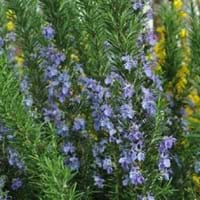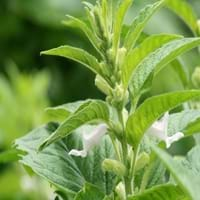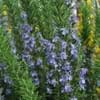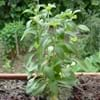Life Span
Perennial
Annual
Origin
Southern Europe, Mediterranean
Africa
Types
Arp Rosemary, Gorizia Rosemary, Lockwood de Forest Rosemary, Salem Rosemary
White Sesame, Black Sesame, Golden Sesame
Habitat
Dry areas, Open scrub
Cultivated Beds
USDA Hardiness Zone
8-11
9-11
AHS Heat Zone
12-8
Not Available
Sunset Zone
H1, H2, 4, 5, 6, 7, 8, 9, 10, 11, 12, 13, 14, 15, 16, 17, 18, 19, 20, 21, 22, 23, 24
Not Available
Habit
Oval or Rounded
Upright/Erect
Flower Color
Blue Violet
White, Pink, Lavender
Flower Color Modifier
Bicolor
Bicolor
Fruit Color
Not Available
Green, Brown
Leaf Color in Spring
Sea Green
Not Available
Leaf Color in Summer
Sea Green
Green
Leaf Color in Fall
Sea Green
Green
Leaf Color in Winter
Light Green
Light Green
Leaf Shape
Needle like
Lanceolate
Plant Season
Spring, Summer, Fall, Winter
Summer
Sunlight
Full Sun
Full Sun, Partial Sun
Growth Rate
Fast
Very Fast
Type of Soil
Loam, Sand
Loam, Sand
The pH of Soil
Neutral, Alkaline
Neutral
Soil Drainage
Well drained
Well drained
Bloom Time
Early Spring, Spring, Late Spring, Late Winter
Indeterminate
Tolerances
Drought
Drought
Where to Plant?
Container, Ground, Pot
Ground
How to Plant?
Seedlings, Stem Planting
Seedlings
Plant Maintenance
Medium
Medium
Watering Requirements
Do not water frequently, Does not require lot of watering, It cannot sustain wet-feet, Never Over-water, Requires watering in the growing season, Water when soil is dry, when new, water every week
Average Water Needs
In Summer
Lots of watering
Lots of watering
In Spring
Moderate
Moderate
In Winter
Average Water
Average Water
Soil pH
Neutral, Alkaline
Neutral
Soil Type
Loam, Sand
Loam, Sand
Soil Drainage Capacity
Well drained
Well drained
Sun Exposure
Full Sun
Full Sun, Partial Sun
Pruning
Prune for shortening long shoots, Prune if you want to improve plant shape, Prune regularly, Prune to control growth, Requires extensive pruning
Remove damaged leaves, Remove dead branches, Remove dead leaves
Fertilizers
All-Purpose Liquid Fertilizer
Apply N-P-K
Pests and Diseases
Mealybugs, Powdery mildew, Root rot, Scale, Spider mites, Whiteflies
Dry root rot, Phyllody, Phytophthora blight, Red blotch
Plant Tolerance
Drought
Drought
Flower Petal Number
Single
Single
Fragrant Bark/Stem
Yes
Yes
Foliage Texture
Fine
Medium
Foliage Sheen
Matte
Matte
Attracts
Bees
Not Available
Allergy
Skin rash, Vomiting
Abdominal pain, Anaphylaxis, breathing problems, Mouth itching, Nausea
Aesthetic Uses
Beautification, Showy Purposes
Not Used For Aesthetic Purpose
Beauty Benefits
Not Available
Prevents greying of hair, Remove blemishes, Speed hair growth
Environmental Uses
Air purification
Air purification
Medicinal Uses
Antioxidants, Cough, Gastrointestinal disorders, Heartburn, High blood pressure, Indigestion
Astringent, Diuretic, Emollient, Nutritive, Tonic
Part of Plant Used
Flowers, Leaves
Leaves, Seeds
Other Uses
Air freshner, Oil is used for aromatherapy, Oil is used in perfume, soaps, creams, etc., Showy Purposes, Used as a spice
Used for making soaps, Used for producing cooking oil, Used in salads
Used As Indoor Plant
Sometimes
No
Used As Outdoor Plant
Yes
Yes
Garden Design
Container, Edible, Hedges, Herb / Vegetable, Mixed Border, Topiary / Bonsai / Espalier
Edible, Herb / Vegetable
Botanical Name
ROSMARINUS officinalis 'Tuscan Blue'
SESAMUM indicum
Common Name
Rosemary, Tuscan Blue Rosemary
Sesame
In Hindi
टस्कन ब्लू दौनी
तिल
In German
Tuscan Blau Rosmarin
Sesam
In French
Toscane Bleu Rosemary
Sésame
In Spanish
Toscana azul Romero
Sésamo
In Greek
Τοσκάνης Μπλε Rosemary
Σουσάμι
In Portuguese
Tuscan Azul Rosemary
Sésamo
In Polish
Toskańskie Niebieski Rosemary
Sezam
In Latin
Tusci Rosemary blue
Sesamae
Phylum
Magnoliophyta
Magnoliophyta
Class
Magnoliopsida
Magnoliopsida
Family
Lamiaceae
Pedaliaceae
Clade
Not Available
Angiosperms, Asterids, Eudicots
Tribe
Not Available
Not Available
Subfamily
Not Available
Asternae
Number of Species
Not Available
Importance of Tuscan Blue Rosemary and Sesame
Want to have the most appropriate plant for your garden? You might want to know the importance of Tuscan Blue Rosemary and Sesame. Basically, these two plants vary in many aspects. Compare Tuscan Blue Rosemary and Sesame as they differ in many characteristics such as their life, care, benefits, facts, etc. Every gardener must at least have the slightest clue about the plants he wants to plant in his garden. Compare their benefits, which differ in many ways like facts and uses. The medicinal use of Tuscan Blue Rosemary is Antioxidants, Cough, Gastrointestinal disorders, Heartburn, High blood pressure and Indigestion whereas of Sesame is Astringent, Diuretic, Emollient, Nutritive and Tonic. Tuscan Blue Rosemary has beauty benefits as follows: Not Available while Sesame has beauty benefits as follows: Not Available.
Compare Facts of Tuscan Blue Rosemary vs Sesame
How to choose the best garden plant for your garden depending upon its facts? Here garden plant comparison will help you to solve this query. Compare the facts of Tuscan Blue Rosemary vs Sesame and know which one to choose. As garden plants have benefits and other uses, allergy is also a major drawback of plants for some people. Allergic reactions of Tuscan Blue Rosemary are Skin rash and Vomiting whereas of Sesame have Abdominal pain, Anaphylaxis, breathing problems, Mouth itching and Nausea respectively. Having a fruit bearing plant in your garden can be a plus point of your garden. Tuscan Blue Rosemary has no showy fruits and Sesame has no showy fruits. Also Tuscan Blue Rosemary is not flowering and Sesame is not flowering . You can compare Tuscan Blue Rosemary and Sesame facts and facts of other plants too.





